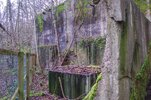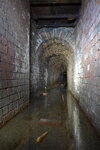I first visited this old mine a few years ago, but having not yet worked out how to take photos in dark places my pics were crap, frankly.... More recently I’ve spent a bit of time searching for other mine entrances in various woodland across Sheffield with varied success, so I retuned for a quick revisit of this place to get some better photos. Not far into the tunnel you reach a collapsed section, so it barely constitutes an ‘explore’ (unless you have more of a death wish than me), but its worth a look. A few years ago, the whole of Loxley Valley was full of derelict places: Loxley Chapel (now burnt down), Kenyons Precision Grindings (now converted to flats), Bradfield Water Works (now a bigger mess), Dysons (just above the valley, now demolished). This pretty much leaves Hepworth Refractory down in the bottom of the valley, which has some pretty fancy new mobile CCTV and pretty responsive security, considering it is essentially an empty shell. This small clay mine behind the site was one of a number of local mines linked to the brick factory.
Some history
During the 1800s the Loxley Valley became an important producer of refractory bricks for the expanding Sheffield steel industry. The bricks were used to line the furnaces and were made from ganister, a sort of sandstone and from fireclay from the Stannington pot clay seam which was prevalent in the Loxley area. Many ganister and fireclay mines existed in the area supplying the local firms of Siddons Bros. (Ganister), Thomas Wragg & Sons (Old Wheel Brick Works) and Thomas Marshall and Co. (Storrs Bridge Brick Works) and later Hepworths, which sprang up in the district and produced the bricks. Refractory production ceased in the area in the 1990s. Wraggs and Marshalls along with Dysons at nearby Stannington, specialised in manufacturing fireclay based casting pit refractory holloware for the steel industry worldwide. Carblox, part of the Marshall group, shared the Storrs Bridge Works site manufacturing carbon blocks for use in hearths in blast furnaces.
https://en.m.wikipedia.org/wiki/Loxley,_South_Yorkshire
Some pics of the surrounding buildings from my original visit sometime in 2013.
And here’s the mine in December 2017 - it’s been covered in graffiti over the last few years, but inside the mine remains the same.
After a small section of newer brickwork there’s a small archway into the older bricked section.
A small amount of water covers the tracks that lead further into the mine.
And although it’s tempting, I’m not in any hurry to go any further.
Back...
And out...





 so yep I see the benefits now. Youve explained that perfectly . Thanks tarkovsky
so yep I see the benefits now. Youve explained that perfectly . Thanks tarkovsky